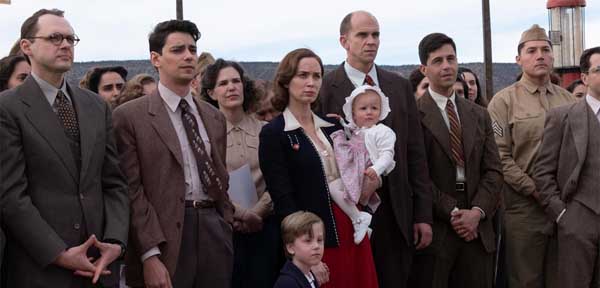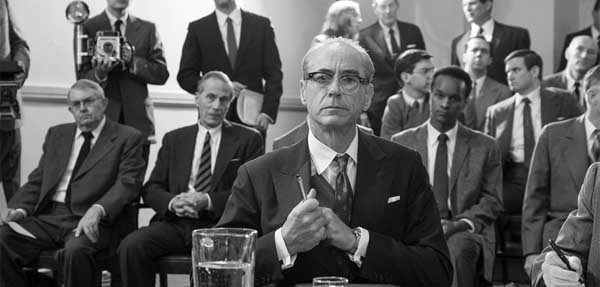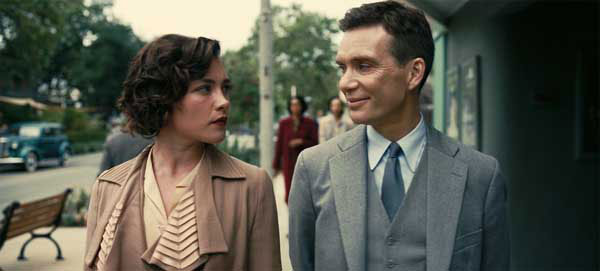Filmmakers, Screenwriters, Performance, Reviews, Film Reviews, Streaming

OPPENHEIMER
I saw Christopher Nolan’s blockbuster atomic bomb movie, “Oppenheimer” back in July when it opened alongside “Barbie” as part of the cinematic double punch of the year. My plan at the time was to write a dual review comparing the merits and deficiencies of both films, but I became so overwhelmed by the calamitous nightmare of Gerwig’s cinematic train wreck that I ended up not talking about Nolan’s movie at all. At the time, what I most remembered about “Oppenheimer” was Emily Blunt’s courtroom scene where she fiercely schooled a mean prosecutor for the inexactness of his language. In one short three minute exchange, Blunt produced more genuine heat onscreen than Nolan’s meticulous staging of the Los Alamos bomb test had a half hour earlier.
Yet, over the next few weeks I struggled to come up with something relevant to say about “Oppenheimer.” As one of the biggest films of the year, it behooved me to weigh in, but the movie hadn’t left a strong enough impression on me. I didn’t love it and I didn’t hate it and there’s nothing more inconsequential than writing (or asking others to read) a “meh” review, so I gave up. But then last week it dropped onto various streaming platforms and I decided to give Nolan’s three hour epic another look. And I’m glad I did, because the second time through proved to be a much more satisfying experience. The film chronicles the creation of the atomic bomb and its grim aftermath through the eyes of its “father,” J. Robert Oppenheimer (a marvelously focused Cillian Murphy).
Jumping back and forth through various time periods and points of view, the intricate plot is a model of efficiency and propulsive storytelling. With its seventy-three speaking parts, two judicial hearings, various love affairs, heaps of skullduggery, espionage, and betrayals, plus the heist-like planning and production of the first weapon of mass destruction, “Oppenheimer” is chock-a-block with moving parts. The fact that Nolan managed to bring it all into a nearly seamless non-linear package is a minor miracle. And the first hour is all plusses. Through the use of almost nonstop montage, we are quickly introduced to the main characters, the multiple time periods, the hearings (already in progress) and the origin story of Oppenheimer, who we discover in college as a clumsy student: bad at math but awesome at theory. Things happen so quickly that “Oppenheimer” starts to feel like one of those movie trailers where they tell you the whole plot: a barrage of quick-cuts that drop us into a scene just long enough to get the headlines, before dashing off to the next location.
And the dialog seems trailer-made as well, designed for maximum exposition and quotability. Sequences contain more information than seems possible; events (and more events) encroach from all sides like dominoes falling in a massive chain reaction. In one short scene, for instance, we get a Christmas party, the disappearance of a valuable scientist, the surprise arrival of physicist Niels Bohr, the news that the U.S. has pulled ahead of the Nazis in the race to make the bomb, a palpable warning about the danger that nukes pose to the world, and a telephone call relaying the apparent suicide of a main character. Phew! It’s fairly clear that Nolan is not going for realism here as much as an almost figurative symbolism, where his putative humans don’t engage in actual conversations, but instead mouth terse ideologies like characters in a Greek play. Yet strangely, in the context Nolan has created, it all works. For a while, at least. The cracks start to show in the film’s second hour with the introduction of Jean Tatlock (Florence Pugh), a communist party member who Oppenheimer has an affair with.
Pugh can be a stunning presence (she’s remarkable in “Midsommar” and “Little Women”), but she simply doesn’t have the passion or tenacity to convey the vast depth of feeling and drive you’d expect from a Marxist true believer, relying instead on her patented, ceaseless pout to carry her performance. And her inexplicable nude scenes are a gross miscalculation on Nolan’s part, having no purpose whatsoever except to show off Pugh’s breasts, which, though lovely, are laughably intrusive under the circumstances. We’re also introduced to a series of near-cartoon villains played by Casey Affleck, Dane DeHaan and David Dastmalchian, who broadcast their dastardly intentions with the subtlety of a wrecking ball. The subplot they are attached to, about accusations that Oppenheimer sold nuclear secrets to the Russians, is the least successful thread in Nolan’s film, primarily due to the ham-fisted fashion in which it’s conveyed. But then we get the stunning showstopper of the Los Alamos A-bomb test followed by the movie’s emotional climax where Oppenheimer speaks to a crowd of cheering supporters after the successful destruction of Hiroshima. Here, Nolan takes a much needed sidestep into abstraction, contrasting the victorious thrill of the moment with the inner workings of Oppenheimer’s guilt-ridden mind. What he imagines, as he speaks exultantly to bleachers full of stomping fanatics, brings the moving message of the film to poignant, brutal life. From this point, however, things get dicey, since there’s still an hour of film left and the conclusions of two not very interesting hearings to wade through. Now, instead of moving swiftly from point to point with his heretofore featherlight touch, Nolan slows down and starts to dig into the obvious. Jason Clarke, as special counsel Roger Robb, plays exactly one color of derisive snideness from beginning to end, making his interrogation scenes feel utterly pat. And over in the other hearing, where Lewis Strauss (Robert Downey Jr), a high-ranking member of the U.S. Atomic Energy Commission is hoping to be named Secretary of Commerce, things are even worse, due to Downey Jr’s exhausting, clenched fist of a performance.
It’s always a gamble when you take an actor known for their effervescent charm and ask them to play a repellent creep. And though Downey Jr starts off great, effectively leaning into the ambiguous murk of Strauss’ ingratiating sycophancy, by the end of the film he’s ground himself down to a twisted nub of fury that totally limits his range as an actor. His performance is closed off: he never lets us in. Consequently, his big final scene, which should’ve been a triumph, feels curdled, small and unconvincing. Still, the story of a man who gets humiliated and decides to use his power to enact revenge upon the world remains sadly relevant to our current political climate where one-upmanship is the rule of the day. (Strauss’ plan to take down Oppenheimer, after being publicly slighted by him, is eerily reminiscent of Trump’s decision to run for president after Obama trashed him at the 2011 Washington Correspondent’s dinner). The technical aspects of the film, as always with Nolan, are magnificent, especially the mind-meltingly complex editing of Jennifer Lame and Ludwig Göransson’s terrific, mood-enhancing score.
And the big idea at the core of the film: that Oppenheimer didn’t fight back against the politically motivated move to discredit him because he saw it as fit punishment for having created the bomb in the first place, is a compelling subject for Nolan. It brought to mind director Scott Elliott’s terrific and woefully underrated “A Map of the World,” in which Sigourney Weaver’s character accidentally commits an unforgivable act and then sits quietly by as her life gets destroyed, seeming to welcome the fall from grace as expiation for her crime. “Oppenheimer” is probably too long. And there are some casting (and directing) choices that limit its ability to reach the heights it might’ve achieved otherwise. But it’s still a very good film, and one that got even better on a second viewing. It’s hard not to admire the phenomenal talent and excellence that have gone into its creation. STREAMING ON AMAZON PRIME |
|
An LA-based playwright, JUSTIN TANNER has more than twenty produced plays to his credit, including Voice Lessons, Day Drinkers, Space Therapy, Wife Swappers, and Coyote Woman. His Pot Mom received the PEN-West Award for Best Play. He has written for the TV shows Gilmore Girls, My So-Called Life and the short-lived Love Monkey. He wrote, directed and edited 88 episodes of the web series Ave 43, available on YouTube. Tanner is the current Playwright in Residence for the Rogue Machine Theatre in Hollywood, where his most recent play Little Theatre, of December of 2022, was met with rave reviews. Charles McNulty of the LA Times writes, "Engrossing... a comedy à clef... “Little Theatre” is invaluable.'"
|

To receive a free subscription to our Sunday Lounge! newsletter, Click Here
Have a suggestion? Send an email to the Editor, Click Here















